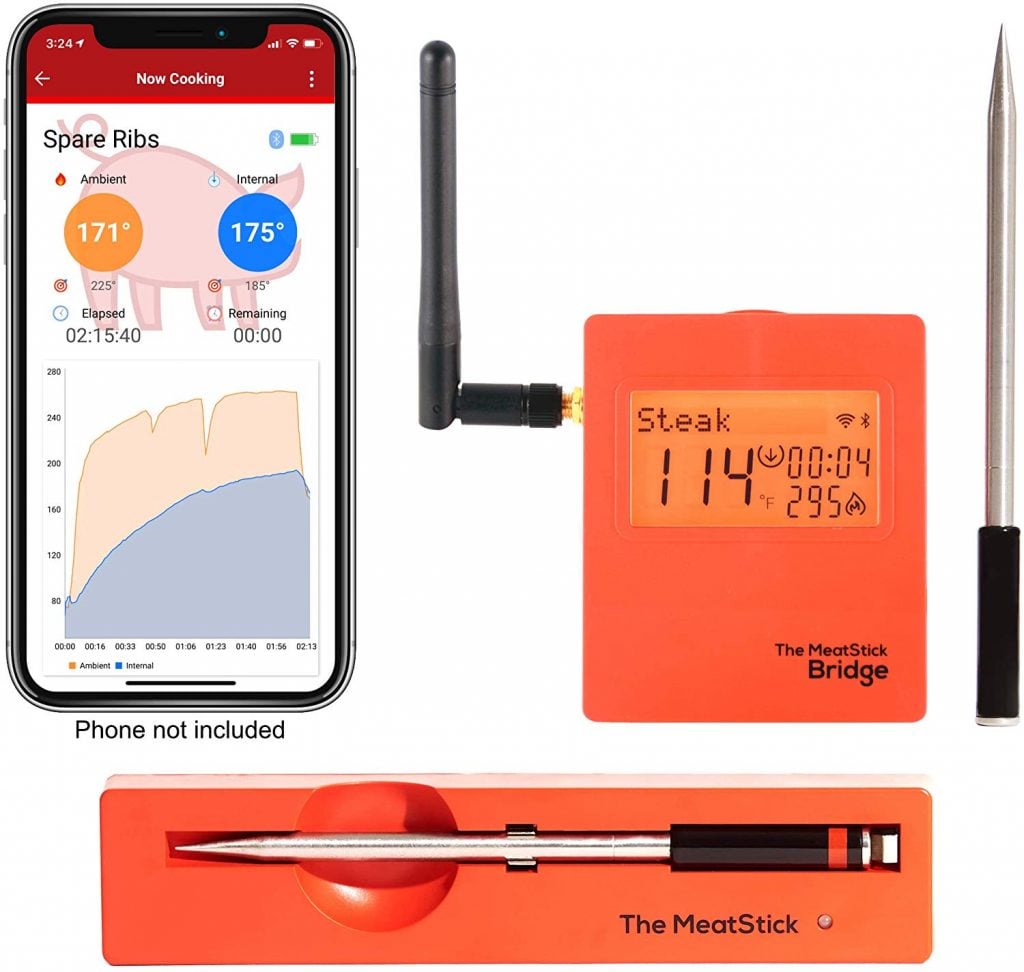YOU ARE HERE >> AmazingRibs » Ratings & Reviews » Ratings Reviews And Buying Guides » Best Thermometers For Food And Cooking » How to Buy the Best In-Food/In-Cooker Thermometer » Meatstick Wi-Fi-Bluetooth Food Thermometer Review
Meatstick Wi-Fi-Bluetooth Food Thermometer Review
All of our reviews are done independently by our team of testers and are in no way influenced by advertising or other monetary compensation from manufacturers. Click here to learn more about our unbiased product review process.
Published On: 10/19/2019 Last Modified: 11/6/2025

The Meatstick Wi-Fi-Bluetooth Food Thermometer is a collection of tools that allows a wireless temperature probe to communicate with a smart phone to monitor cooking progress. The maximum distance between the probe and the phone is determined by the configuration used.
In the simplest arrangement, the probe can communicate directly with the smart phone via Bluetooth. With no intervening structures, my phone could communicate with the Stick over distances of around 100′ (30m) when the probe was placed on a non-conductive tabletop. If I placed the Stick inside my Weber Smokey Mountain (WSM) on top of a non-conducting pad about 4″ (10cm) above the grill surface, the maximum distance over which reliable communications could be maintained dropped to around 30′ (10m). A lag of a couple of minutes between loss of communication or regaining communication made it difficult to establish these distances with greater accuracy. After losing contact with the probes (I tested both of them at the same time), one probe could re-establish communications while the other did not. I would get unusual messages about taking the probe out of the charger when it was not in the charger. If the probe was out of contact with the phone for long enough, the cooking session would terminate, causing loss of data and requiring a new session to be created.
The charger can only charge one probe at a time. The very limited instructions suggest that the probe must be in the charger while communications are established, but I was sometimes able to connect to both probes when they were not in the charger.
An optional accessory ($30 USD) called the Xtender can be used to increase range. This device receives the signal from the probe and amplifies it. With the Xtender placed close to the cooker, in this case a WSM, it can receive the attenuated signals and re-transmit them to the phone. When using the Xtender, I could receive signals up to 150-200′ (45-60m) away from the WSM.
The third device in the communication path is the Bridge. It receives the Bluetooth signal from either the probe directly or via the Xtender and relays it to your router. The router communicates with the cloud, allowing the user to access temperature anywhere an internet connection is available. The Bridge must be connected to a USB power supply: it has no provision for internal batteries. This might be a big inconvenience if you don’t have an outlet nearby and don’t want to dig out an extension cord to run a thermometer.
Each probe has two temperature sensors: a food sensor and an ambient sensor. The probe also contains all the electronics, including a rechargeable battery, needed to transmit the temperature data. Electronics can be fussy about operating temperatures, so the probes rely on the thermal inertia of food to prevent the probe shaft from rising above 212°F (100°C). The end of the probe that remains outside the food can operate safely up to 572°F (300°C). But are the temperature sensors accurate?
I tested the accuracy of the food end of the probes by placing them in a water bath of known temperature and noting the readings. At 32°F (0°C), both probes read correctly, although I suspect that 32° is as low as they’ll go. At 130°F, the two probes read 127° and 125°. At 165°F, the probes read 162° and 160°, and at 200°F, the probes read 198° and 196°. A five degree disparity at 130° could mean the difference between perfection and slightly overcooked meat. Most food thermometers today will be within a degree or two of nominal, so these are a bit off. I tested the ambient temp probe by inserting the food end into a soaked cotton sock that simulated the thermal conductivity of meat. (Meat is mostly water.) I then placed the sock and probe into an oven next to a temperature probe of known accuracy. I set the oven for 325°F (163°C). As expected, the sock rose in temperature until about 155°F when the stall occurred. The ambient temperature read 297°F when the actual temp was 322°F. I would not rely on the probe’s ambient temperature readout when trying to determine the cooker’s internal temperature.
The app provides an overview of each probe. For unexplained reasons, the two probes’ readings would swap places every five seconds or so, requiring the user to read the probe name to determine which temp was which. I found this distracting and annoying. By touching the probe’s display, you can drill down to a more detailed view of the probe’s status, including the food temp, the ambient temp, a temp vs. time graph, the alarm thresholds – both food and ambient – and an estimate of the cook time remaining. The time estimate may work for grilling a steak, but it’s useless if you’re slow cooking something like a brisket. The reason is that predictive algorithms can’t account for temperature plateaus like the stall. Beware of placing much faith in such predictions. To be fair, nobody else has figured out how to make this work, either.

The instructions come in two forms: a 5″x5″ card with a high-level overview of what to do and a collection of videos viewable on your phone. The app will walk you through setup and making Wi-Fi connections, but troubleshooting tips are sparse if things don’t go as expected. Personally, I find videos a PITA; I’d rather have something printed that I can refer to while going through the steps. Call me old school! What do you do if you want to connect to a different router, for example? I couldn’t find any guidance on that and other setup questions.
This product is remarkably similar to the Meater Block that we have tested and reviewed. There were similar issues and concerns with it, but I encountered fewer problems and therefore gave it a more favorable review. The Meatstick still has some glitches to work out.
I have concerns about the susceptibility of the probes to high temperatures and the longevity of the internal batteries. Connections weren’t always reliable. The need for AC power (or a USB battery pack) when using the Bridge is a nuisance. Not having a way to keep the batteries charged while not in use means added steps when planning to cook. Probe temperature accuracy was sub-par. Poor printed documentation makes using the product more difficult. Overall, not my favorite food thermometer.
Click the buttons below to search our complete database of reviews:
Product Information:
-
Thermometer Function:Leave in Food, Leave in Cooker, Wireless Remote
-
Item Price :179.99
*Price Subject To Change -
Where to buy (buying from this supplier supports this website):
-
Probe:(2) Length: 4.19" (104mm), diameter: 0.255" (6.5mm)
-
Battery Type:Rechargeable in probes, AA in Xtender,
-
Battery Life:Probe: 24 hrs. per manufacturer
-
Min & Max Temp:Food: 32-212°F (0-100°C); ambient: 572°F (300°C)
-
Display Precision:0.1°
-
Actual Temp at 32 Degrees:32/32
-
Actual Temp at 130 Degrees:127/125
-
Actual Temp at 225 Degrees:n/a
-
Actual Temp at 325 Degrees:n/a
-
Speed from 32 to 212 Degrees:n/a
-
Numbers Display Size:0.562" (14mm)
-
Water Resistance Rating:Not water resistant
-
C/F Switch:Built in CF switch
-
Backlight:Built in Backlight
-
Color Options:Orange
-
App:iOS, Android
-
Included:2 Probes, Extender (optional for $30 extra), Bridge, Charger, Carrying case, USB cables,
-
Available Accessories:Range extender (Xtender)
-
Alarms:Audible/Visible
Manufacturer:
-
MeatStick
Related reviews
- Yummly Wireless Meat Thermometer Review
- MeatStick X Wireless Food Thermometer Review
- Tappecue Touch And Airprobe2 Bundle Review
-
Bill McGrath, AmazingRibs.com Chief Thermometer Reviewer - Bill McGrath is AmazingRibs.com's Thermometer Maven. He has sophisticated equipment, an electrical engineering degree from Cornell University, and an MBA (almost) from UC Berkeley.
Up Your BBQ IQ By Joining The Pitmaster Club

Sign up for a free trial of the AmazingRibs.com Pitmaster Club and experience everything that the world’s largest membership-based BBQ and grilling community has to offer!

High quality websites are expensive to run. If you help us, we’ll pay you back bigtime with an ad-free experience and a lot of freebies!
Millions come to AmazingRibs.com every month for high quality tested recipes, tips on technique, science, mythbusting, product reviews, and inspiration. But it is expensive to run a website with more than 2,000 pages and we don’t have a big corporate partner to subsidize us.
Our most important source of sustenance is people who join our Pitmaster Club. But please don’t think of it as a donation. Members get MANY great benefits. We block all third-party ads, we give members free ebooks, magazines, interviews, webinars, more recipes, a monthly sweepstakes with prizes worth up to $2,000, discounts on products, and best of all a community of like-minded cooks free of flame wars. Click below to see all the benefits, take a free 30 day trial, and help keep this site alive.
Post comments and questions below
1) Please try the search box at the top of every page before you ask for help.
2) Try to post your question to the appropriate page.
3) Tell us everything we need to know to help such as the type of cooker and thermometer. Dial thermometers are often off by as much as 50°F so if you are not using a good digital thermometer we probably can’t help you with time and temp questions. Please read this article about thermometers.
4) If you are a member of the Pitmaster Club, your comments login is probably different.
5) Posts with links in them may not appear immediately.
Moderators